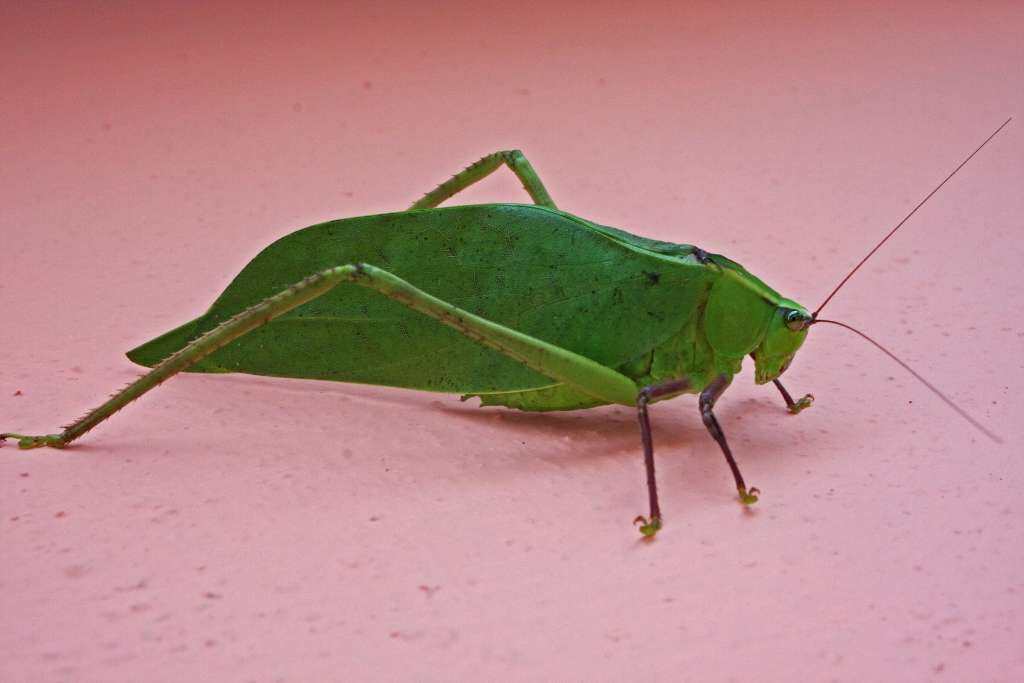SCORES & OUTDOORS: Katydids are considered gentle insects not harmful to humans
 by Roland D. Hallee
by Roland D. Hallee
Last week, a friend of mine texted me with the photo of a cricket-like bug for identification. Before I could get back to him, he ID it as a katydid. A few days later, I saw one hanging on the screen door at camp. It had been a while since I had seen one.
Katydids are a family of insects related to grasshoppers and crickets. They’re also called bush crickets or long-horned grasshoppers in some regions. There are more than 6,000 types of katydids, and they’re found on every continent except for Antarctica. The vast majority of katydid species live in the tropical regions of the world. For example, the Amazon basin rain forest is home to over 2,000 species of katydids. However, katydids are found in the cool, dry temperate regions, as well, with about 255 species in North America.
Most types of katydids are green and have markings to help them blend in with leaves and other foliage. Like crickets and grasshoppers, they have long back legs to help them jump. They can rub their front wings together to make a loud ka-ty-did song that gives them their name. Some katydid songs, however, are at too high a frequency for human ears to hear.
Katydids are usually considered gentle insects that aren’t harmful to humans. Some people consider them garden pests; however, they usually don’t cause serious damage to your plants or vegetables. The Common Garden Katydid is a quite common backyard buddy and garden visitor.
Many people even keep them as pets. In rare cases, larger types of katydid may pinch or bite if they feel threatened. Their bite is unlikely to break your skin and likely won’t be any more painful than a mosquito bite. You’re very unlikely to get bitten unless you’re handling them with your bare hands. It’s extremely unlikely that the bite will need medical attention. You can wash the area with soap and water and apply a cold compress if you have pain or swelling.
Katydids primarily eat leaves and grass. Along with crickets and grasshoppers, they may be attracted to the plants in your garden or any tall grass on your property. Katydids are nocturnal and are also attracted to bright lights at night.
One type of katydid found widely across North America, the broad-winged katydid, likes to eat the leaves of citrus trees and may be a pest for people with orchards.
You may not know much about katydids, probably because they are masters of camouflage. Their green colouring and leaf-like shape helps them blend into leafy surroundings, and they are most active at night. They may be tough to spot, but may be a lot more common than you think.
Katydids don’t have ears on their heads, but instead they have an ear called a ‘tympanum’ on each front leg, just below the knee. Up close, this looks like a hole in their leg.
The lifespan of a katydid is about a year, with full adulthood usually developing very late. Females most typically lay their eggs at the end of summer beneath the soil or in plant stem holes. The eggs are typically oval and laid in rows on the host plant.
When katydids go to rest during the day, they enter a diurnal roosting posture to maximize their cryptic qualities. This position fools predators into thinking the katydid is either dead or just a leaf on the plant. By flicking their wings open when disturbed, they use the coloration to fool predators into thinking the spots are eyes. This, in combination with their coloration mimicking leaves, allows them to blend in with their surroundings, but also makes predators unsure which side is the front and which side is the back.
They have polygamous relationships. The first male to mate is guaranteed an extremely high confidence of paternity when a second male couples at the termination of female sexual refractoriness. The nutrients that the offspring ultimately receive will increase their fitness.
The polygamous relationships of the katydids lead to high levels of male-male competition. Male competition is caused by the decreased availability of males able to supply nutrients to the females. Females produce more eggs on a high-quality diet; thus, the female looks for healthier males with more nutrition. Females use the sound created by the male to judge his fitness. The louder and more fluent the trill, the higher the fitness of the male.
When you think about it, there is a lot that goes on in the world of what we consider “just a bug.”
Roland’s trivia question of the week:
Which retired former Red Sox player is married to Olympic and World Cup soccer player Mia Hamm?
Responsible journalism is hard work!
It is also expensive!
If you enjoy reading The Town Line and the good news we bring you each week, would you consider a donation to help us continue the work we’re doing?
The Town Line is a 501(c)(3) nonprofit private foundation, and all donations are tax deductible under the Internal Revenue Service code.
To help, please visit our online donation page or mail a check payable to The Town Line, PO Box 89, South China, ME 04358. Your contribution is appreciated!


Leave a Reply
Want to join the discussion?Feel free to contribute!